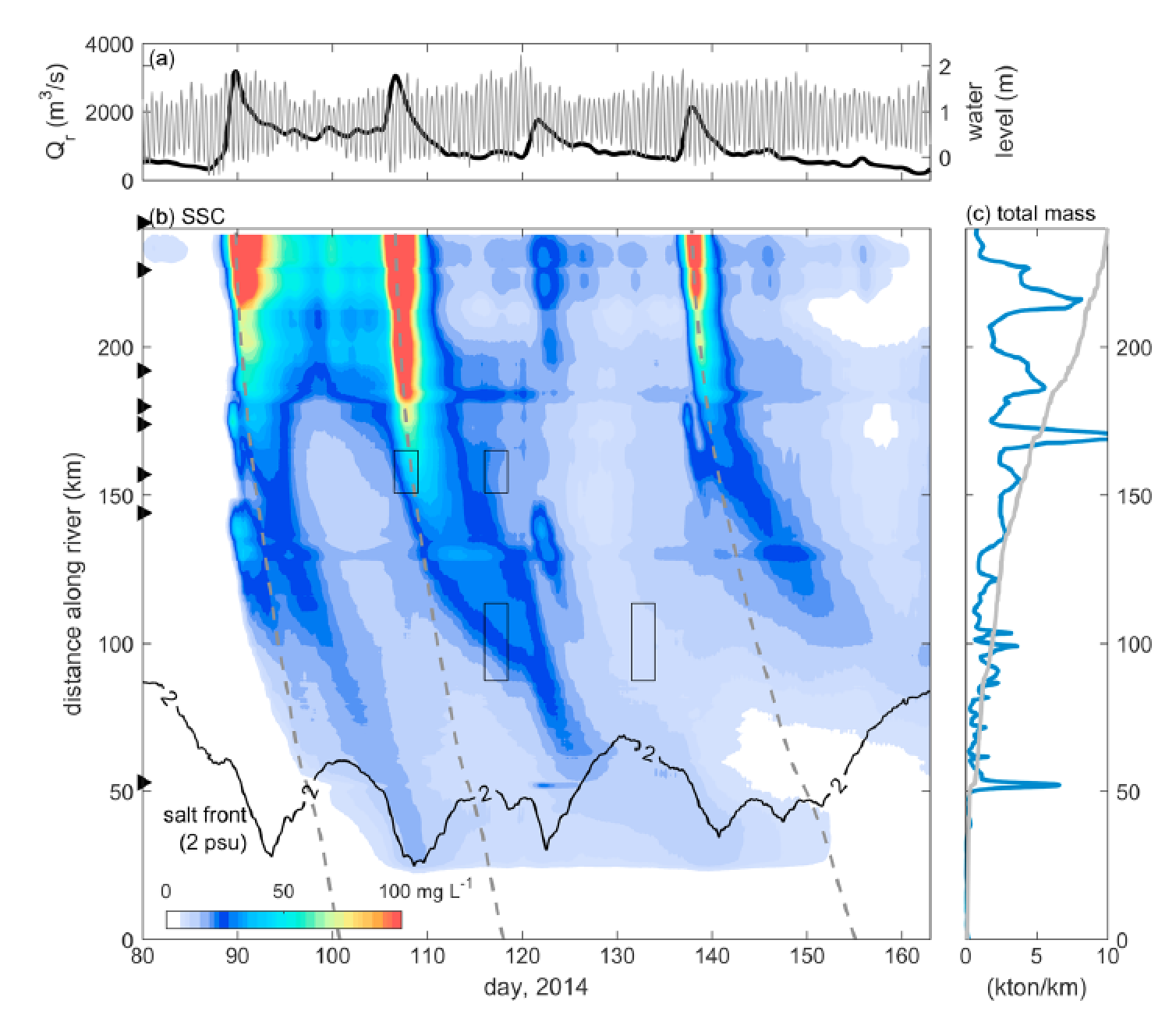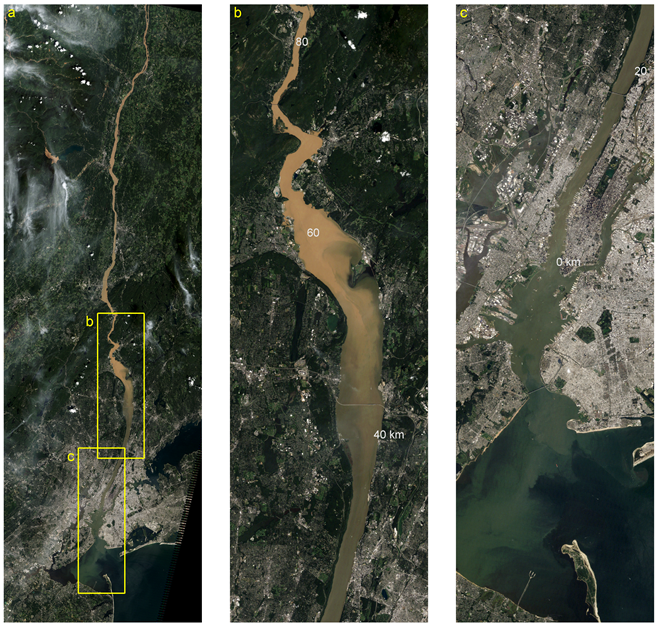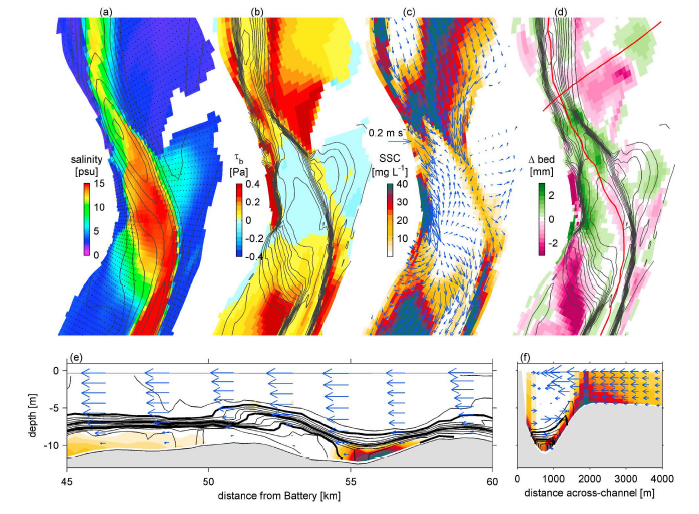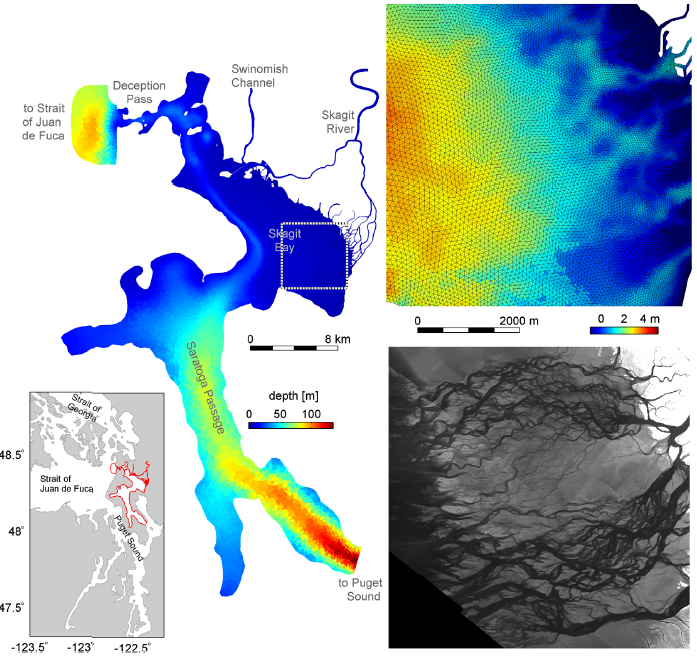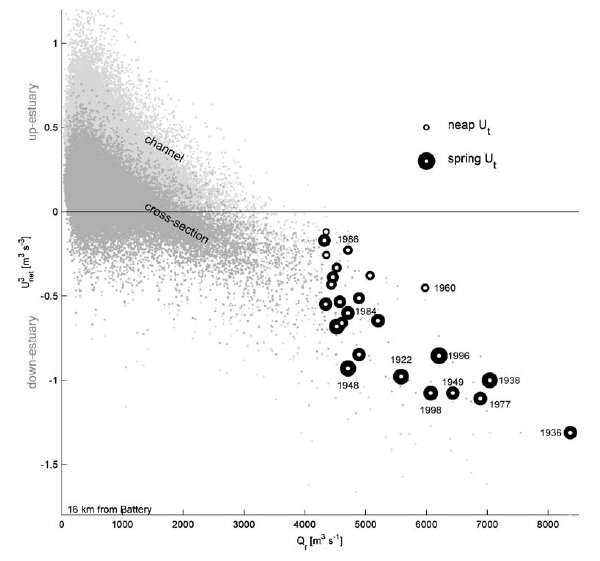Sediment transport
Sediment transport over long time scale determines the estuarine bathymetry, which provides a leading order control on the estuarine dynamics. At shorter time scales, an understanding of sediment transport is necessary to predict the distribution and fate of contaminants that are often adsorbed to sediment in industrialized estuaries, as well as for the impact on dredging for navigation. We have examined how estuarine dynamics, specifically bottom salinity fonts and lateral bathymetric gradients, alter sediment trapping and transport in partially mixed estuaries like the Hudson, tidal salt wedge estuaries like the Connecticut, and on fluvial tidal flats in San Francisco Bay and Puget Sound. We also have quantified the importance of extreme events for the highly non-linear processes of sediment delivery and transport, as with events in the Hudson due to recent tropical storms and over the past century.
Selected publications
Sediment transport in a tidal river
Ralston, DK and WR Geyer, 2017. Sediment transport time scales and trapping efficiency in a tidal river. J. Geophys. Res. Earth Surface, 122, 2042–2063. https://doi.org/10.1002/2017JF004337.
In many rivers, a large region of tidally influenced freshwater is located upstream from the saline estuary. We use observations and a numerical model to characterize how sediment moves through the tidal Hudson River. A sediment budget shows that about 40% of the sediment entering the tidal river remains trapped for an extended period. High discharge events disproportionately account for the sediment that is trapped, and suspended sediment pulses during events move seaward more slowly than the river flow by a factor of 1.5 to 3. With the model we show that both the trapping efficiency and seaward transport rate depend primarily on settling velocity, which can vary by orders of magnitude from clay to fine sand. The transport rate decreases linearly with settling velocity, such that time scales for sediment to move through the estuary are several years to several decades, much greater than the variation in river discharge at event or seasonal time scales.
The Hudson after Irene and Lee
Ralston, DK, JC Warner, WR Geyer, and GR Wall, 2013. Sediment transport due to extreme events: the Hudson River estuary after Tropical Storms Irene and Lee. Geophys. Res. Let., 40(20):5451-5455, doi:10.1002/2013GL057906.
Runoff from Tropical Storms Irene and Lee in 2011 introduced about 2.7 Mton of new sediment to the Hudson River, about 5 times the annual average. Rather than the conventional wisdom that sediment would be trapped in the estuary, we show with observations and a model that ~2/3 of the new sediment remained in the tidal freshwater river more than a month after the storms, and only ~1/5 reached the estuary. Instead, the high sediment concentrations seen in the estuary were likely due to remobilization of bed sediment by to high stresses and reduced stratification from the storms.
Frontal trapping and lateral partitioning of sediment flux
Ralston, DK, WR Geyer, and JC Warner, 2012. Bathymetric controls on sediment transport in the Hudson River estuary: lateral asymmetry and frontal trapping. J. Geophys Res., 117, C10013, doi:10.1029/2012JC008124.
Lateral gradients in depth, and therefore estuarine circulation and stratification, lead to sediment fluxes that are strongly landward in the channel and seaward on the shoals. Bottom salinity fronts form at bathymetric expansions at multiple locations along the estuary, and convergences at the fronts create local maxima in suspended sediment and deposition, providing a general mechanism for creation of secondary ETMs. Lateral sediment fluxes between channel and shoals vary with the spring-neap cycle, going from regions of higher to lower bed stress depending on the elevation of the pycnocline relative to the bed. Lateral and along-channel gradients in bathymetry and thus stratification, bed stress, and sediment flux lead to an unsteady, heterogeneous distribution of sediment transport rather than the traditional schematic of trapping at an ETM at the salinity limit.
Sediment flux on deltaic tidal flats
Ralston, DK, WR Geyer, PA Traykovski, and NJ Nidzieko, 2013. Effects of estuarine and fluvial processes on sediment transport over deltaic tidal flats, Contintental Shelf Res., 60, S40-S57, doi:10.1016/j.csr.2012.02.004.
River discharge over tidal flats supplies freshwater buoyancy and suspended sediment, and despite the extremely shallow water depths, strong salinity fronts and stratification develop and favor flood-directed residual flows. The river discharge during low tides drains through a network of distributary channels on the exposed tidalflats with strongly ebb-directed stresses. The net sediment transport depends on the balance between estuarine and fluvial processes, and is modulated on spring-neap time scales by the tides of PugetSound. The baroclinic pressure gradient and periodic stratification enhance trapping during neap tides,while theprimary means of moving sediment off the tidal flats are the high stresses in the distributary channels during late ebb of spring low tides.
Long term sediment flux in the Hudson
Ralston, DK and WR Geyer, 2009. Episodic and long-term sediment transport in the Hudson River estuary. Estuaries and Coasts, 32, 1130–1151, doi: 10.1007/s12237-009-9206-4.
A simplified model of the estuarine dynamics is used to calculate sediment transport in the Hudson River estuary from 1918 to 2005. Lateral depth variation across the estuary affects the estuarine circulation and consequently the net sediment flux, with up-estuary transport in the channel and down-estuary on the shoals. Sediment transport capacity depends largely on river discharge, but also on the timing of discharge events during the spring–neap cycle and the duration of events compared with the estuarine response time. Maximum sediment transport during high discharge events coincides with maximum sediment supply from the watershed, but the nearly cubic discharge dependence of sediment supply greatly exceeds the linear increase in estuarine transport capacity. Consequently, sediment accumulates in the estuary during the highest flow conditions and is exported during more moderate discharge conditions.
